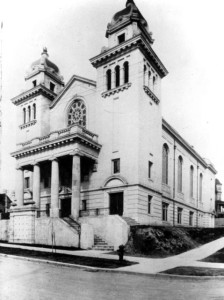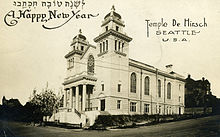Temple De Hirsch Sinai
In 1899, Seattle’s Reform Jews established Temple De Hirsch, which they named after the nineteenth-century French philanthropist, Baron Maurice De Hirsch.
Services were held at Jefferson Hall and Morris Hall.
The first president was Leo Kohn and the first rabbi was Rabbi Theodore F. Joseph.
David Kaufman, who helped found Temple De Hirsch, donated the Torah scroll that he purchased in New York for Congregation Ohaveth Sholem, the city’s short-lived first synagogue.
In 1899, Temple De Hirsch opened a Sunday School in order to prepare children for their Bar/Bat Mitzvah and Confirmation ceremonies. The first teachers were Merle Degginger and Ida Gottstein.
Merle Degginger also founded the Ladies Auxiliary in 1899 with former members of Congregation Ohaveth Sholem.
The First Building — 1901
In 1900, Temple De Hirsch purchased land for $4,050 for its building on the northwest corner of Marion Street and Boylston Avenue.
Construction began in 1901. At that time, Temple De Hirsch was 1,000 members strong.
Temple De Hirsch also established a choir.
In 1906, the congregation hired Rabbi Samuel Koch, who served as spiritual leader for 37 years.
Due to a lack of funds, the building was not completed; only the basement and vestry were finished.
The Temple board decided to move locations and put their fundraising efforts into a larger building, which could allow for the congregation’s continued growth.
The Second Building – 1908
In 1907, Temple De Hirsch began construction of their new, bigger synagogue at Union Street and Fifteenth Avenue.
The dedication ceremony was held in 1908, presided over by Rabbi Koch.
Also in 1908, the temple library was established. Today, the Temple De Hirsch Sinai Library contains over 10,000 books.
In 1909, Rabbi Koch started Temple Tidings, Temple De Hirsch’s newsletter, as a weekly publication. Temple Tidings is still published on a bi-monthly schedule.
In 1910, Temple De Hirsch purchased Hills of Eternity Cemetery from Congregation Ohaveth Sholem.
In 1920, the Temple Men’s Club was established.
In 1942, Rabbi Raphael Levine became rabbi of Temple De Hirsch.
Rabbi Levine created a local television show called Challenge, in which he brought together Catholic, Protestant, and Jewish clergy to discuss various issues on people’s minds. The show was successful and lasted for 14 years.
Samuel Goldfarb was the musical director of Temple De Hirsch from 1930-1967. He composed numerous liturgical melodies and holiday songs, such as “I Have a Little Dreidel,” a Chanukah musical staple, and compiled song collections with his brother, Rabbi Israel Goldfarb, composer of the well-known melody for Shalom Aleichem, among other ubiquitous synagogue songs.
The Third Building – 1960
To accommodate growth, in 1960 Temple De Hirsch built a new synagogue building at 1511 E. Pike Street, on the corner of Sixteenth Avenue.
The building was designed by B. Marcus Priteca, John Dettie, and John Peck. Priteca also designed Seattle’s Chevra Bikur Holim (now Langston Hughes Performing Arts Institute) and Congregation Herzl.
Rabbi Earl Starr was the spiritual leader from 1970 to 2001.
In 1971, Temple De Hirsch merged with Temple Sinai, the Bellevue Reform Congregation.
Since then, the congregation has been known as Temple De Hirsch Sinai, and is made up of two campuses: the Seattle facility on Pike Street and the Bellevue facility at 3850 156th Avenue.
Since Rabbi Starr’s retirement in 2001, Temple De Hirsch Sinai has been led by its senior rabbi, Daniel A. Weiner.
Source
-
Molly Cone, Howard Droker, and Jaqueline Williams, Family of Strangers: Building a Jewish Community in Washington State (Seattle: University of Washington Press, 2003).
Samantha Silver is curator for this Temple De Hirsch Sinai exhibit.


